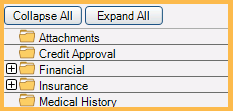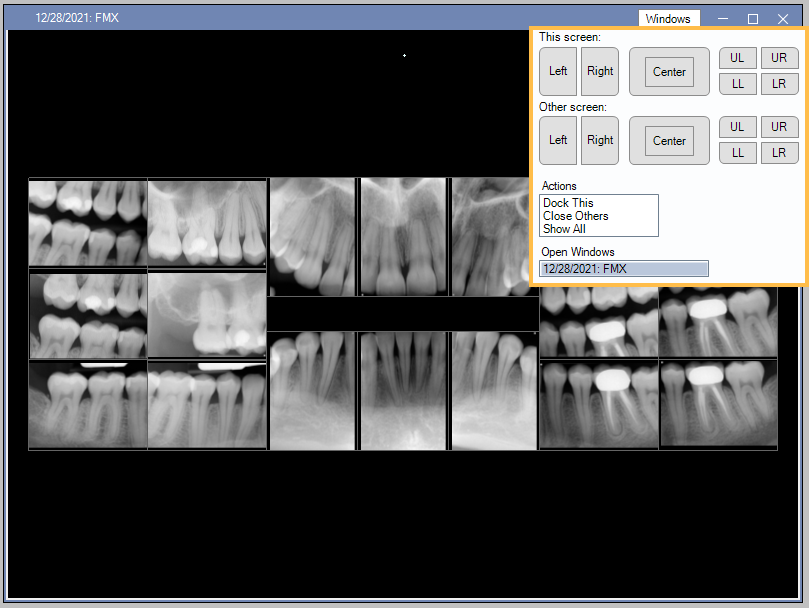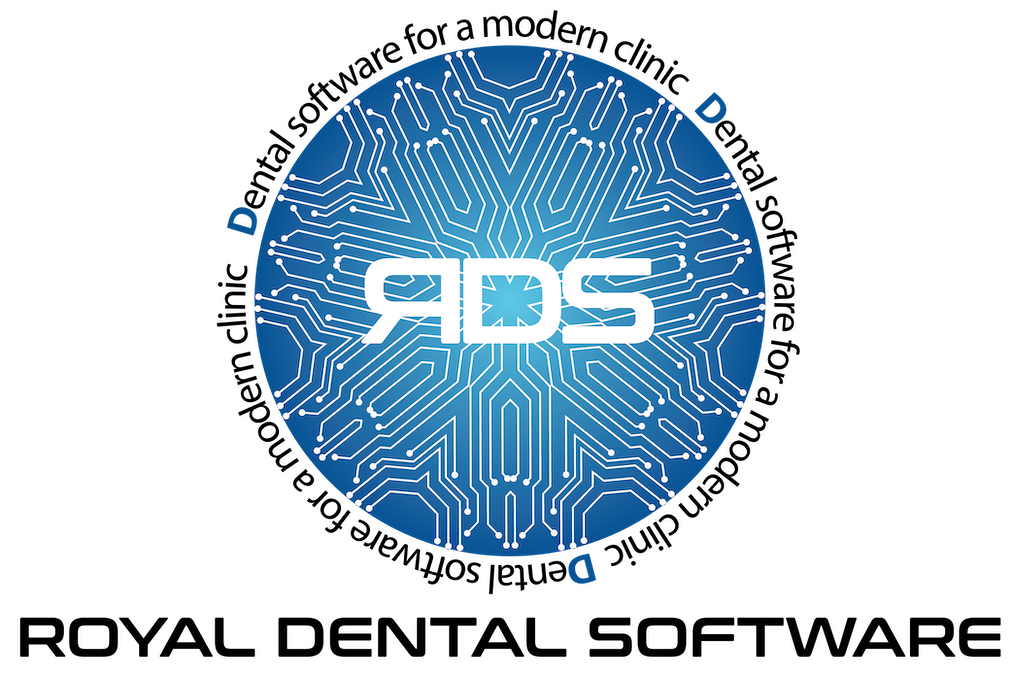Imaging Module
The Imaging Module is a place to scan and store most images, radiographs, forms, and letters that you would normally store in a paper chart.

When you scan or capture forms or images, they are saved as simple jpg or tif files. In addition, you can also import other file types, including Word, PDF, and Excel formats.
External Software versus Royal dental Software
For many years, we focused on building Program Bridges to other imaging software. We have now added enough features that you should not need any separate imaging software. You can take your radiographs directly in Royal dental Software. See Sensor Compatibility
Images Toolbar
Print: Opens the Select Printer window so you can print the selected image. The image will automatically be sized to fit the printed page. Not available for PDFs.
Delete: Delete the selected image.
Info: Open Item Info window to view or edit image or document information (e.g., category, name, date, etc.)
Sign: Open the Signature window to attach a note to the selected image and electronically sign it. See Electronic Signatures.
Scan Document: Use the flatbed scanner of your attached device to Scan a single-page document. Single-page scans save as a JPEG file.
Scan Multi-Page Document: Use the automatic document feeder (ADF) of your attached device to scan multiple pages. Multi-page documents are saved as PDF files.
Scan Radiograph: Select when you are scanning a radiograph. The pixel windowing settings set in Imaging Setup will be used as the default. Radiograph is automatically selected as the Type. Radiograph scans save as a JPEG file. Also see Enhancing Radiograph Images.
Scan Photo: Scan a photo. Photo is automatically selected as the Type. Photo scans save as a JPEG file.
Mount / Acquire: Click to take images using an imaging device. See Select Mount and Acquire. To utilize imaging in Royal dental Software, first set up Imaging Devices and Mount Definitions.
Video: Click to open the Video Capture window. Use the live feed to take images and intraoral photos.
Import: Import an existing file from your computer or network. Set a default path to import images from by entering the Default import folder in Preferences. When an image is imported, the Item Info window will pop up to enter notes and information.
- If an Image Category is selected, the imports go to the selected folder.
- If no Image Category is selected, and there is a Default Image Category set in Preferences, imports go to the default category.
- If no Image Category is selected, and there no default Image Category set in Preferences, imports go to the first folder in the Image Categories.
- Import Automatically: This could potentially be used by some phosphor plate systems. If they allow you to designate a folder where they will drop new images, then use the same folder as the default here. Set the Default folder for automatic import in Preferences. Click Start. As images are dropped in by the other software, they will be automatically imported. Once scanning is complete, click Stop.

- Change: Click to select a different folder.
- Go To: Click to go to the currently selected folder.
- Start: Click to start the automatic import.
- Stop: Click to stop the automatic import.
- Close: Click to close the automatic import interface.
Export: Export a file to another location on your computer or network.
- Move to Patient: Move the currently selected image or document to a different patient. The Select Patient window will open, allowing the user to select an existing patient or create a new patient to move the file to. Automatically switches to the newly selected or created patient, so the file can be moved to a different category (folder), as needed.
Copy: Copy the selected image to the clipboard. Does not work with PDFs.
Paste: Paste files or bitmaps from the clipboard into the selected mount position or image folder.
Forms: Click the dropdown to quickly add frequently used PDF files or images (e.g., surveys, after care instructions, brochures) to the selected image category. Once added to a patient, click Sign to add notes or an electronic signature. To add forms to the dropdown, navigate to Forms in the RoyalDentImages folder. Paste any documents or images into this folder. Restart Royal dental Software to view newly added templates.
The options below only work with image files, not PDFs.
- Slider: Click and drag each edge of the slider left or right to adjust the pixel windowing values for the selected image. Windowing is useful for images like radiographs because it isolates gray levels. Changes are visible in the preview as you drag. For more details, see Enhancing Radiograph Images.
- Zoom: Zoom by dragging, using the +/- buttons, typing in the box, or using the mouse scroll wheel.
- Fit: Click to fit the image to the screen.
- 100: Click to zoom to 100%, one image pixel per screen pixel.
- Fit 1: Only available for mounts. Click to fit the selected mount image to fit the screen.
- Crop: Click to activate, then click and drag to draw a rectangle around the part of the image you want to keep. When you release the mouse button, a confirmation message will show. Click OK to remove the parts of the image outside of the drawn rectangle. This is reversible and can be reset in the Item Size window.
- Pan: Click to activate, then drag the image to reposition.
- Adjust: Only available for mounts. Once activated, drag to adjust an image slightly, or to move it to a different position in the mount.
- Size/Rotation: Click an image file or image within a mount, then click to adjust the image. See Mount Size for details.
- FlipH, -90, +90, 180: The last four buttons let you flip and rotate the image. This is for display only and does not alter the original image.
- Draw: See the Draw tool for details on drawing, adding text, adding lines, and adding measurements to an image.
- Unmount: Only available when viewing mounts. Select an image from the mount, then click to unmount it. Useful for moving images around. An Unmounted section will appear at the bottom.
- Remount: Use to remount an image. First, click the open spot on the mount, select the image, then click to remount it.
- Delete: Use to delete an image from a mount. First, unmount the image, select the image, then click to delete it.
- Retake: Use to retake an image. Select the image, then click to retake it.
- Close: Click to close the Unmounted section. Cannot be closed if images are left in the section.

Image Categories

Files are organized in tree view by categories (folders). The documents within a folder/category are based on files stored in the patient's A to Z Folder. See Definitions: Image Categories to customize folders/categories.
Collapse All: Click to collapse all folders. Use the +/- symbols on a folder to expand and collapse as needed.
Expand All: Click to expand all folders. Use the +/- symbols on a folder to expand and collapse as needed.
- An earth behind the folder icon indicates the folder is shared to Patient Portal. See Definitions, Image Categories, Show in Patient Portal.

- Right-click on an image file to print, delete, or get more information. See Image Info.
- Right-click on a mount to print, delete, or get more information. See Mount Info.
- Single click on an image file (jpg, gif) or PDF, to preview it in the window on the right. For other file types, there is no preview capability.
- Drag and drop an image to move it from one category to another.
- Double-click an item to open it in its default program. For example, a Word file (doc) would open in MS Word.
Images are sorted chronologically by the date and time created (hour/minute/seconds). To change the sort order, edit the date and/or time in the info window (see Image Info).
Images stored in the category designated as Show as Thumbnails and in Chart module will display as a thumbnail within the folder.
Viewing Images
To view multiple images at once, select the first image, drag the image to the side using the title bar, then select the next image.

To move an image to a specific spot on the screen, click Windows in the upper right corner of the image.

- This Screen: Click where on the current monitor/screen to place the image.
- Other Screen: Move the image to a specific spot on another monitor/screen.
- Actions:
- Dock This: Dock this image to the Imaging Module.
- Close Others: Close any other open images.
- Show All: Open any minimized images.
- Open Windows: Displays any open images.
Moving Files into the Imaging Module
To move files into the Imaging Module, you have a number of options.
- Scan the documents or images.
- Import files from another location on your computer.
- Drag and drop files from a Windows folder directly into an Images folder. This will not work if Royal dental Software is running as an administrator.
- Copy/Paste an image from the clipboard. Within another program, copy the image to the clipboard (Ctrl + C or Edit, Copy). Or copy an active window to the clipboard by pressing Alt + PrtScn (Print Screen is usually at the top of the keyboard above the arrow keys). Then, in the Imaging Module, select the category and click Paste. Pasted images will not be compressed, but generally only take up 1/4 of the space of a scanned document. See also Print Screen Tool to capture screen shots that you do not want to save with any particular patient.
If you copy/paste an existing image that's already in Royal dental Software, the file size may get bloated, especially if it starts out as a gif. All such images get converted to jpg with zero compression, resulting in some bloat. The current recommendation for duplicating a gif is to copy it directly to the A to Z folders using Windows.Then, return to the Imaging Module and refresh. The new file will be picked up and attached to the patient. - Copy directly into the patient's folder. In Windows, simply select and copy the files, then paste the files into the patient's folder in the A to Z folders. The next time you open the Imaging Module for the patient, the files will be automatically added to the tree view, and you can re-categorize or rename. This is useful when copying large quantities of files at once. Once recognized by Royal dental Software, do not rename or move the files, or Royal dental Software will not know where to find them.
- Also see Placing Images and Documents here: A to Z Folder.
PDF Files
PDF files viewed in Royal dental Software use WebView2. If WebView2 is not installed, a popup will display asking the user to download the installation. This only needs to be done once on each workstation.
Double-click a PDF from the image category to launch it outside of Royal dental Software, using the workstation's default PDF viewer.
To always view PDFs outside of Royal dental Software, enable the Preference, PDF files always launch in a separate window. Users will be required to double-click a PDF to view it.


